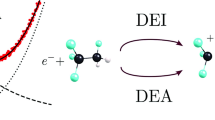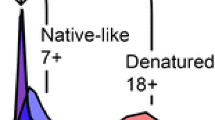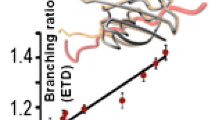Abstract
Electron capture dissociation (ECD) and electron transfer dissociation (ETD) experiments in electrodynamic ion traps operated in the presence of a bath gas in the 1–10 mTorr range have been conducted on a common set of doubly protonated model peptides of the form X(AG)nX (X = lysine, arginine, or histidine, n = 1, 2, or 4). The partitioning of reaction products was measured using thermal electrons, anions of azobenzene, and anions of 1,3-dinitrobenzene as reagents. Variation of n alters the charge per residue of the peptide cation, which affects recombination energy. The ECD experiments showed that H-atom loss is greatest for the n = 1 peptides and decreases as n increases. Proton transfer in ETD, on the other hand, is expected to increase as charge per residue decreases (i.e., as n increases). These opposing tendencies were apparent in the data for the K(AG)nK peptides. H-atom loss appeared to be more prevalent in ECD than in ETD and is rationalized on the basis of either internal energy differences, differences in angular momentum transfer associated with the electron capture versus electron transfer processes, or a combination of the two. The histidine peptides showed the greatest extent of charge reduction without dissociation, the arginine peptides showed the greatest extent of side-chain cleavages, and the lysine peptides generally showed the greatest extent of partitioning into the c/z•-product ion channels. The fragmentation patterns for the complementary c- and z•-ions for ETD and ECD were found to be remarkably similar, particularly for the peptides with X = lysine.

ᅟ






Similar content being viewed by others
References
McLuckey, S.A., Mentinova, M.: Ion/neutral, ion/electron, ion/photon, and ion/ion interactions in tandem mass spectrometry: Do we need them all? Are they enough? J. Am. Soc. Mass Spectrom. 22, 3–12 (2011)
Wells, J.M., McLuckey, S.A.: Collision-induced dissociation (CID) of peptides and proteins. Methods Enzymol. 402, 148–185 (2005)
Little, D.P., Speir, J.P., Senko, M.W., O’Connor, P.B., McLafferty, F.W.: Infrared multiphoton dissociation of large multiply-charged ions for biomolecule sequencing. Anal. Chem. 66, 2809–2815 (1994)
Zubarev, R.A., Kelleher, N.L., McLafferty, F.W.: Electron capture dissociation of multiply charged protein cations. A nonergodic process. J. Am. Chem. Soc. 120, 3265–3266 (1998)
Syka, J.E., Coon, J.J., Schroeder, M.J., Shabanowitz, J., Hunt, D.F.: Peptide and protein sequence analysis by electron transfer dissociation mass spectrometry. Proc. Natl. Acad. Sci. U.S.A. 101, 9528–9533 (2004)
Coon, J.J.: Collisions or electrons? Protein sequence analysis in the 21st century. Anal. Chem. 81, 3208–3215 (2009)
Coon, J.J., Syka, J.E.P., Shabanowitz, J., Hunt, D.F.: Anion dependence in the partitioning between proton and electron transfer in ion/ion reactions. Int. J. Mass Spectrom. 236, 33–42 (2004)
Pitteri, S.J., Chrisman, P.A., McLuckey, S.A.: Electron-transfer ion/ion reactions of doubly protonated peptides: Effect of elevated bath gas temperature. Anal. Chem. 77, 5662–5669 (2005)
Gunawardena, H.P., Gorenstein, L., Erickson, D.E., Xia, Y., McLuckey, S.A.: Transmission mode ion/ion electron-transfer dissociation in a linear ion trap. Int. J. Mass Spectrom. 265, 130–138 (2007)
Breuker, K., Oh, H., Lin, C., Carpenter, B.K., McLafferty, F.W.: Nonergodic and conformational control of the electron capture dissociation of protein cations. Proc. Natl. Acad. Sci. U.S.A. 101, 14011–14016 (2004)
Tureček, F.: N–Cα bond dissociation energies and kinetics in amide and peptide radicals. Is the dissociation a non-ergodic process? J. Am. Chem. Soc. 125, 5954–5963 (2003)
Zubarev, R.A., Kruger, N.A., Fridriksson, E.K., Lewis, M.A., Horn, D.M., Carpenter, B.K., McLafferty, F.W.: Electron capture dissociation of gaseous multiply-charged proteins is favored at disulfide bonds and other sites of high hydrogen atom affinity. J. Am. Chem. Soc. 121, 2857–2866 (1999)
Zubarev, R.A.: Reactions of polypeptide ions with electrons in the gas phase. Mass Spectrom Rev. 22, 57–77 (2003)
Zubarev, R.A., Haselmann, K.F., Budnik, B., Kjeldsen, F., Jensen, F.: Towards an understanding of the mechanism of electron-capture dissociation: A historical perspective and modern ideas. Eur. J. Mass Spectrom. 8, 337–349 (2002)
Hudgins, R., Hakansson, K., Quinn, J.P., Hendrickson, C.L., Marshall, A.G.: Proceedings of the 50th ASMS Conference on Mass Spectrometry and Allied Topics, Orlando, Florida (June 2–6, 2002) A020420
Syrstad, E.A., Tureček, F.: Toward a general mechanism of electron capture dissociation. J. Am. Soc. Mass Spectrom. 16, 208–224 (2005)
Sobczyk, M., Anusiewicz, W., Berdys-Kochanska, J., Sawicka, A., Skurski, P., Simons, J.: Coulomb-assisted dissociative electron attachment: Application to a model peptide. J. Phys. Chem. A 109, 250–258 (2005)
Anusiewicz, W., Berdys-Kochanska, J., Simons, J.: Electron attachment step in electron capture dissociation (ECD) and electron transfer dissociation (ETD). J. Phys. Chem. A 109, 5801–5813 (2005)
Anusiewicz, W., Berdys-Kochanska, J., Skurski, P., Simons, J.: Simulating electron transfer attachment to a positively charged model peptide. J. Phys. Chem. A 110, 1261–1266 (2006)
Sobczyk, M., Simons, J.: The role of excited Rydberg states in electron transfer dissociation. J. Phys. Chem. B 110, 7519–7527 (2006)
Neff, D., Simons, J.: Analytical and computational studies of intramolecular electron transfer pertinent to electron transfer and electron capture dissociation mass spectrometry. J. Phys. Chem. A 114, 1309–1323 (2010)
Simons, J.: Mechanisms for S–S and N–Cα bond cleavage in peptide ECD and ETD mass spectrometry. Chem. Phys. Lett. 484, 81–95 (2010)
Simons, J.: Analytical model for rates of electron attachment and intramolecular electron transfer in electron transfer dissociation mass spectrometry. J. Am. Chem. Soc. 132, 7074–7085 (2010)
Moss, C.L., Chung, T.W., Wyer, J.A., Nielsen, S.B., Hvelplund, P., Tureček, F.: Dipole-guided electron capture causes abnormal dissociations of phosphorylated pentapeptides. J. Am. Soc. Mass Spectrom. 22, 731–751 (2011)
Loo, R.R.O., Udseth, H.R., Smith, R.D.: Evidence of charge inversion in the reaction of singly charged anions with multiply charged macroions. J. Phys. Chem. 95, 6412–6415 (1991)
Stephenson, J.L., McLuckey, S.A.: Ion/ion reactions in the gas phase: Proton transfer reactions involving multiply-charged proteins. J. Am. Chem. Soc. 118, 7390–7397 (1996)
Scalf, M., Westphall, M.S., Krause, J., Kaufman, S.L., Smith, L.M.: Controlling charge states of large ions. Science 283, 194–197 (1999)
Loo, R.R.O., Udseth, H.R., Smith, R.D.: A new approach for the study of gas-phase ion-ion reactions using electrospray ionization. J. Am. Soc. Mass Spectrom. 3, 695–705 (1992)
Wells, J.M., Chrisman, P.A., McLuckey, S.A.: “Dueling” ESI: Instrumentation to study ion/ion reactions of electrospray-generated cations and anions. J. Am. Soc. Mass Spectrom. 13, 614–622 (2002)
Wells, J.M., Chrisman, P.A., McLuckey, S.A.: Formation of protein−protein complexes in vacuo. J. Am. Chem. Soc. 123, 12428–12429 (2001)
He, M., McLuckey, S.A.: Two ion/ion charge inversion steps to form a doubly protonated peptide from a singly protonated peptide in the gas phase. J. Am. Chem. Soc. 125, 7756–7757 (2003)
He, M., Emory, J.E., McLuckey, S.A.: Reagent anions for charge inversion of polypeptide/protein cations in the gas phase. Anal. Chem. 77, 3173–3182 (2005)
Landau, L.D.: Zur Theorie der Energieubertragung. II. Phys. Z. 2, 46–51 (1932)
Zener, C.: Non-adiabatic crossing of energy levels. Proc. R. Soc. Lond. A 137, 696–702 (1932)
McLuckey, S.A.: The emerging role of ion/ion reactions in biological mass spectrometry: Considerations for reagent ion selection. Eur. J. Mass. Spectrom. 16, 429–439 (2010)
Gunawardena, H.P., He, M., Chrisman, P.A., Pitteri, S.J., Hogan, J.M., Hodges, B.D.M., McLuckey, S.A.: Electron transfer versus proton transfer in gas-phase ion/ion reactions of polyprotonated peptides. J. Am. Chem. Soc. 127, 12627–12639 (2005)
Baba, T., Hashimoto, Y., Hasegawa, H., Hirabayashi, A., Waki, I.: Electron capture dissociation in a radio frequency ion trap. Anal. Chem. 76, 4263–4266 (2004)
Silivra, O.A., Kjeldsen, F., Ivonin, I.A., Zubarev, R.A.: Electron capture dissociation of polypeptides in a three-dimensional quadrupole ion trap: Implementation and first results. J. Am. Soc. Mass Spectrom. 16, 22–27 (2005)
Ling, L., Brancia, F.L.: Electron capture dissociation in a digital ion trap mass spectrometer. Anal. Chem 78, 1995–2000 (2006)
Satake, H., Hasegawa, H., Hirabayashi, A., Hashimoto, Y., Baba, T., Masuda, K.: Fast multiple electron capture dissociation in a linear radio frequency quadrupole ion trap. Anal. Chem. 79, 8755–8761 (2007)
Xia, Y., Gunawardena, H.P., Erickson, D.E., McLuckey, S.A.: Effects of cation charge-site identity and position on electron-transfer dissociation of polypeptide cations. J. Am. Chem. Soc. 129, 12232–12243 (2007)
Ivarone, A.T., Peach, K., Williams, E.R.: Effects of charge state and cationizing agent on the electron capture dissociation of a peptide. Anal. Chem. 76, 2231–2238 (2004)
Tsybin, Y.O., Haselmann, K.F., Emmett, M.R., Hendrickson, C.L., Marshall, A.G.: Charge location directs electron capture dissociation of peptide dications. J. Am. Soc. Mass Spectrom. 17, 1704–1711 (2006)
Crizer, D.M., McLuckey, S.A.: Electron transfer dissociation of amide nitrogen methylated polypeptide cations. J. Am. Soc. Mass Spectrom. 20, 1349–1354 (2009)
Liu, J., McLuckey, S.A.: Electron transfer dissociation: Effects of cation charge state on product partitioning in ion/ion electron transfer to multiply protonated polypeptides. Int. J. Mass Spectrom. 330/332, 174–181 (2012)
Good, D.M., Wirtala, M., McAlister, G.C., Coon, J.J.: Performance characteristics of electron transfer dissociation mass spectrometry. Mol. Cell. Proteom. 6, 1942–1951 (2007)
Pitteri, S.J., Chrisman, P.A., Hogan, J.M., McLuckey, S.A.: Electron transfer ion/ion reactions in a three-dimensional quadrupole ion trap: Reactions of doubly and triply protonated peptides with SO2 -•. Anal. Chem. 77, 1831–1839 (2005)
Reid, G.E., Simpson, R.J., O’Hair, R.A.J.: A mass spectrometric and ab initio study of the pathways for dehydration of simple glycine and cysteine-containing peptide [M + H]+ ions. J. Am. Soc. Mass Spectrom. 9, 945–956 (1998)
Hager, J.W.: A new linear ion trap mass spectrometer. Rapid Commun. Mass Spectrom. 16, 512–526 (2002)
Liang, X., Xia, Y., McLuckey, S.A.: Alternately pulsed nanoelectrospray ionization/atmospheric pressure chemical ionization for ion/ion reactions in an electrodynamic ion trap. Anal. Chem. 78, 3208–3212 (2006)
Xia, Y., Wu, J., Londry, F.A., Hager, J.W., McLuckey, S.A.: Mutual storage mode ion/ion reactions in a hybrid linear ion trap. J. Am. Soc. Mass Spectrom. 16, 71–81 (2005)
Xia, Y., Liang, X., McLuckey, S.A.: Pulsed dual electrospray ionization for ion/ion reactions. J. Am. Soc. Mass Spectrom. 16, 1750–1756 (2005)
Londry, F.A., Hager, J.W.: Mass selective axial ion ejection from a linear quadrupole ion trap. J. Am. Soc. Mass Spectrom. 14, 1130–1147 (2003)
Compton, P.D., Strukl, J.V., Bai, D.L., Shabanowitz, J., Hunt, D.F.: Optimization of electron transfer dissociation via informed selection of reagents and operating parameters. Anal. Chem. 84, 1781–1785 (2012)
Mahan, B.H.: Recombination of gaseous ions. Adv. Chem. Phys. 23, 1–40 (1973)
Olson, R.E.: Absorbing-sphere model for calculating ion-ion recombination total cross sections. J. Chem. Phys. 56, 2979–2991 (1972)
Olson, R.E., Smith, F.T., Bauer, E.: Estimation of the coupling matrix elements for one-electron transfer systems. Appl. Opt. 10, 1848–1855 (1971)
Budnik, B.A., Tsybin, Y.O., Hakansson, P., Zubarev, R.A.: Ionization energies of multiply protonated polypeptides obtained by tandem ionization in Fourier transform mass spectrometers. J. Mass Spectrom. 37, 1141–1144 (2002)
Stephenson Jr., J.L., McLuckey, S.A.: Ion/ion reactions in the gas-phase: Proton transfer reactions involving multiply-charged proteins. J. Am. Chem. Soc. 118, 7390–7397 (1996)
Wells, J.M., Chrisman, P.A., McLuckey, S.A.: Formation and characterization of protein–protein complexes in vacuo. J. Am. Chem. Soc. 125, 7238–7249 (2003)
Bates, D.R., Morgan, W.L.: New recombination mechanism -tidal termolecular ionic recombination. Phys. Rev. Lett. 64, 2258–2260 (1990)
Morgan, W.L., Bates, D.R.: Tidal termolecular ionic recombination. J. Phys. B At. Mol. Opt. Phys. 25, 5421–5430 (1992)
Tureček, F., Jones, J.W., Towle, T., Panja, S., Nielsen, S.B., Hvelplund, P., Paizs, B.: Hidden histidine radical rearrangements upon electron transfer to gas-phase peptide ions. Experimental evidence and theoretical analysis. J. Am. Chem. Soc. 130, 14584–14596 (2008)
Tureček, F., Chen, X.H., Hao, C.T.: Where does the electron go? Electron distribution and reactivity of peptide cation radicals formed by electron transfer in the gas phase. J. Am. Chem. Soc. 10, 8818–8833 (2008)
Chung, T.W., Tureček, F.: Amplified histidine effect in electron transfer dissociation of histidine rich peptides from histatin 5. Int. J. Mass Spectrom. 306, 99–107 (2011)
Tureček, F., Chung, T.W., Moss, C.L., Wyer, J.A., Ehlerding, A., Holm, A.I.S., Zettergren, H., Nielsen, S.B., Hvelplund, P., Rooke, J.C., Bythell, B., Paizs, B.: The histidine effect. Electron transfer and capture cause different dissociations and rearrangements of histidine peptide cation-radicals. J. Am. Chem. Soc. 132, 10728–10740 (2010)
Chen, X., Tureček, F.: The arginine anomaly: Arginine radicals are poor hydrogen atom donors in electron transfer induced dissociations. J. Am. Chem. Soc. 128, 12520–12530 (2006)
Tsybin, Y.O., Haselmann, K.F., Emmett, M.R., Hendrickson, C.L., Marshall, A.G.: Charge location directs electron capture dissociation. J. Am. Soc. Mass Spectrom. 17, 1704–1711 (2006)
Vorobyev, A., Ben Hamidane, H., Tsybin, Y.O.: Electron capture dissociation product ion abundances at the X amino acid in RAAAA-X-AAAAK peptides correlate with amino acid polarity and radical stability. J. Am. Soc. Mass Spectrom. 20, 2273–2283 (2003)
Simons, J., Ledvina, A.R.: Spatial extent of fragment-ion abundances in electron transfer dissociation and electron capture dissociation mass spectrometry of peptides. Int. J. Mass Spectrom. 330, 84–94 (2012)
Tureček, F., Moss, C.L., Chung, T.W.: Correlating ETD fragment ion intensities with peptide ion conformational and electronic structure. Int. J. Mass Spectrom. 330, 207–219 (2012)
van der Rest, G., Hui, R., Frison, G., Chamot-Rooke, J.: Dissociation channel dependence on peptide size observed in electron capture dissociation of tryptic peptides. J. Am. Soc. Mass Spectrom. 22, 1631–1644 (2011)
Syrstad, E.A., Stephens, D.D., Tureček, F.: Hydrogen atom adducts to the amide bond. Generation and energetics of amide radicals in the gas phase. J. Phys. Chem. A 107, 115–126 (2003)
Moss, C.L., Liang, W., Li, X., Tureček, F.: The early life of a peptide cation-radical. Ground and excited-state trajectories of electron-based peptide dissociations during the first 330 femtoseconds. J. Am. Soc. Mass Spectrom. 23, 446–459 (2012)
Meisels, G.G., Verboom, G.M.L., Weiss, M.J., Hsieh, T.: Angular momentum in ion-molecule reactions. J. Am. Chem. Soc. 101, 7189–7195 (1979)
Chesnavich, W.J., Bowers, M.T.: Statistical phase space theory of polyatomic systems. Application to the cross section and product kinetic energy distribution of the reaction C2H4 +• + C2H4 → C3H5+ + CH3 •. J. Am. Chem. Soc. 98, 8301–8309 (1976)
Chesnavich, W.J., Bowers, M.T.: Statistical phase space theory of polyatomic systems: Rigorous energy and angular momentum conservation in reactions involving symmetric polyatomic species. J. Chem. Phys. 66, 2306–2315 (1977)
Verboom, G.M.L., Meisels, G.G.: Angular momentum distributions in collision processes and the location of the transition state in ion-molecule reactions. J. Chem. Phys. 68, 2714–2717 (1978)
Acknowledgments
D.M.C. acknowledges support from a grant from the US Department of Energy (DOE), Office of Basic Energy Sciences, Division of Chemical Sciences, Geosciences, and Biosciences, under award DE-FG02-00ER15105. M.M. and W.M.M. acknowledge support from the National Institutes of Health under grant GM 45372.
Author information
Authors and Affiliations
Corresponding author
Rights and permissions
About this article
Cite this article
Mentinova, M., Crizer, D.M., Baba, T. et al. Cation Recombination Energy/Coulomb Repulsion Effects in ETD/ECD as Revealed by Variation of Charge per Residue at Fixed Total Charge. J. Am. Soc. Mass Spectrom. 24, 1676–1689 (2013). https://doi.org/10.1007/s13361-013-0606-0
Received:
Revised:
Accepted:
Published:
Issue Date:
DOI: https://doi.org/10.1007/s13361-013-0606-0




